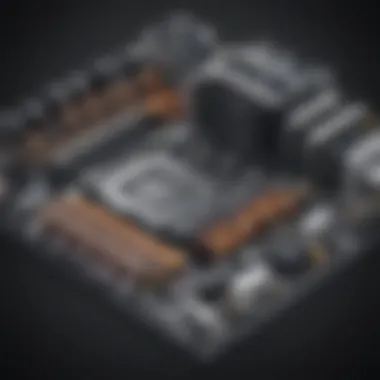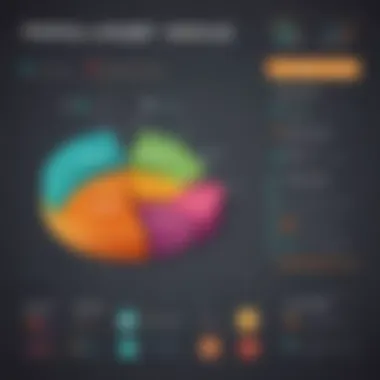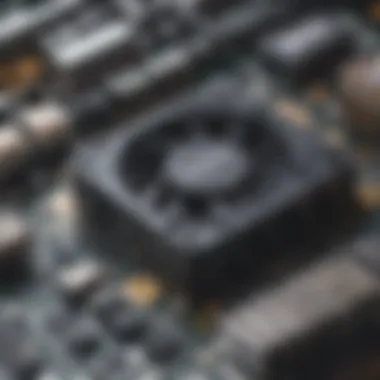Mining Cryptocurrency with GPU: A Comprehensive Guide


Intro
Diving into the world of cryptocurrency mining triggers a mix of excitement and caution for many enthusiasts. As the digital currency landscape evolves, mining has emerged as a cornerstone activity for generating new coins and verifying transactions. While Bitcoin tends to steal the spotlight, an array of altcoins offers fertile ground for exploration as well. This guide focuses on mining with graphics processing units, commonly known as GPUs, which have revolutionized the mining process through enhanced capabilities compared to traditional CPU mining.
Choosing to mine with GPUs prompts numerous questions. Is it worth the investment? What are the technical essentials? How does one balance the costs against potential gains? These inquiries, and many more, will be examined throughout this piece. We aim to illuminate the path for both new and seasoned investors, helping them navigate this intriguing digital financial frontier. In an era where knowledge translates directly into power, understanding the core concepts and strategies of GPU mining is crucial for savvy investors and tech enthusiasts alike.
The importance of financial literacy cannot be overstated in today's fast-paced digital world. Equip yourself with the knowledge this guide provides, and step confidently into the expansive realm of cryptocurrency mining with GPUs.
Understanding Cryptocurrency Mining
Cryptocurrency mining has become a fundamental aspect of the broader digital currency landscape. For those navigating the complex world of cryptocurrencies—whether students, investors, or even analysts—grasping the intricacies of mining is crucial. Mining serves as a means of transaction verification and security within blockchain networks, ensuring that all transactions are legitimate and authenticated. This process doesn't just underpin the operation of cryptocurrencies; it also offers a potential avenue for profit, making it an attractive prospect for countless individuals.
What is Cryptocurrency Mining?
At its core, mining refers to the process of validating transactions and adding them to a blockchain. Each new block—subsequently created and linked to the existing chain—is like a page added to a ledger, confirming that a certain amount of cryptocurrency was sent and received between users. When miners solve complex mathematical problems, they succeed in validating these transactions and in return, they receive a reward in the form of newly minted cryptocurrency.
So, why dive deeper into this topic? Well, mining can be a rewarding venture, but it requires a significant understanding of both the process and its implications. Not all cryptocurrencies are mined the same way, and each presents its own level of complexity and potential rewards. Additionally, the move towards proof-of-stake models in some blockchain networks has changed the game, triggering questions about the future of traditional mining.
The Role of Blockchain Technology
Blockchain technology is the backbone of cryptocurrencies, functioning as a decentralized database that records all transactions across a network of computers. This decentralized nature eliminates the need for a central authority, making the system transparent and resilient against fraud. It's akin to having a community diary where every transaction is publicly logged, visible to all, yet editable by none.
When miners add blocks to the blockchain, they are working with technology that boasts key attributes:
- Transparency: Every transaction is public. Anyone can view the blockchain to verify transactions.
- Security: The cryptographic nature of blockchain makes it resistant to hacking attempts.
- Decentralization: No single entity controls the network, reducing the risk of manipulation.
"Mining is more than just generating coins; it's the lifeblood of crypto transactions, fueling trust and security within the system."
Recognition of the nuances and benefits of mining, paired with the underlying technology, ensures that newcomers can navigate this domain with a stronger sense of awareness and insight.
The Basics of GPU Mining
When it comes to cryptocurrency mining, understanding the basic principles of GPU mining is crucial. This section lays out the foundation of why GPUs are a preferred choice in the realm of mining, exploring their unique advantages and the intricacies involved in utilizing them effectively. With the rising popularity of cryptocurrencies, knowing how to set up and optimize GPU mining can be the linchpin for both novices and seasoned investors seeking to enhance their investment strategies.
Why Choose GPU over Other Mining Options?
The landscape of cryptocurrency mining is diverse. Among the various options available, Graphics Processing Units (GPUs) have gained significant traction. But why opt for GPUs as opposed to other mining hardware like ASICs or CPUs?


- Performance: GPUs are built for parallel processing, allowing them to handle multiple tasks simultaneously. This is vital in mining where numerous calculations are necessary simultaneously. In contrast, ASICs are specifically designed for single mining purposes. They might be more efficient but lack versatility.
- Cost-Effectiveness: While ASIC miners can be remarkably efficient, they often come with hefty price tags. GPUs offer a more budget-friendly alternative. A decent GPU can deliver commendable performance for the investment. The initial outlay is lower, especially for new miners just stepping into the field.
- Flexibility: If mining profitability shifts or a new cryptocurrency emerges, GPU rigs can be repurposed. For instance, if one algorithm falls out of favor, miners can switch to others without needing to replace their entire setup. This adaptability provides a safety net that can be advantageous in an ever-changing market.
- Accessibility: GPUs are widely available through retailers and second-hand markets alike. For those looking to build a mining rig, sourcing components isn't a monumental task, especially compared to the specialized nature of ASIC miners.
These aspects converge to make GPUs a compelling choice for many miners, whether starting small or scaling operations.
How GPUs Work in Mining
To appreciate the effectiveness of GPU mining, one must delve into the mechanisms that drive these powerful units. At the core, mining involves solving complex mathematical problems, specifically securing and verifying transactions on a blockchain. This is where the prowess of GPUs comes to the fore.
- Parallel Processing: Unlike CPUs, which are optimized for sequential processing, GPUs can handle thousands of threads at once. This is critical in cryptocurrency mining, which relies heavily on solving hashing algorithms quickly and efficiently.
- Hash Rate: The effectiveness of a GPU in a mining operation largely hinges on its hash rate, measured in hashes per second (H/s). A higher hash rate translates to a greater number of computations performed every second, increasing the chances of mining a block successfully and receiving rewards.
- Energy Consumption: While GPUs are known for their performance, they also consume a fair bit of power. The balance between the energy consumed and the hash rate achieved is a factor miners weigh heavily when projecting profitability. Over time, more efficient models have emerged, offering greater outputs with reduced energy demands.
- Cooling Requirements: Running multiple GPUs simultaneously generates significant heat. Proper cooling mechanisms are essential to maintain optimal operation. Poorly ventilated rigs can lead to inevitable hardware failure, contributing to losses that could outweigh any potential gains.
Understanding these core elements sheds light on how GPUs maximize mining efficiency, but it also serves as a reminder: effective setups require careful considerations around hardware choices, power costs, and maintenance protocols.
"The best way to predict the future is to create it."
— Peter Drucker
In summary, exploring both why GPUs stand out among mining hardware alternatives and grasping the mechanics behind their operation allows miners to make informed decisions for a productive mining venture.
Setting Up Your Mining Operation
Establishing a successful mining operation using GPUs isn't just a matter of plugging in a few components and calling it a day. It's akin to constructing a finely tuned machine—every part must work harmoniously. A well-thought-out setup is crucial because it ensures that your operation is both efficient and profitable, minimizing potential downtime and maximizing output. The choice of components, the configuration of the rig, and maintenance routines all play a pivotal role in the longevity and profitability of your mining endeavor.
Required Hardware Components
To embark on your GPU mining journey, the first step is gathering the necessary hardware components. A mining rig is predominantly built around the GPU, but it consists of several additional elements that enhance functionality and efficiency. Here’s a checklist of the essential components you’ll need:
- Graphics Processing Unit (GPU): Your workhorse; choose one suited to your budget and mining goals.
- Motherboard: A robust motherboard that supports multiple GPUs is vital; ensure it has enough PCIe slots.
- Central Processing Unit (CPU): While GPUs handle most of the processing, a decent CPU is still necessary for overall system performance.
- Power Supply Unit (PSU): A quality PSU is essential—look for one that provides enough wattage for your setup while maintaining efficiency.
- RAM: Basic RAM of around 4GB to 8GB is usually sufficient for mining tasks.
- Storage: An SSD or HDD to install the operating system and mining software; SSDs are preferred for their speed.
- Cooling Solutions: Adequate cooling is crucial to prevent overheating; consider fans or liquid cooling systems.
Upon assembling these components, it's critical to ensure compatibility across parts. An ill-fitting component can cause headaches down the line.
Selecting the Right GPU
Choosing the right GPU can make or break your mining experience. Not every GPU is capable of efficiently mining all cryptocurrencies; performance may vary based on the algorithm used and electricity costs in your area. Here are key points to ponder:
- Hash Rate: This figure indicates how many calculations a GPU can perform per second. Higher hash rates often mean better performance.
- Power Consumption: Check how many watts a GPU consumes at peak performance. This affects your electricity bill directly, which is a significant factor in overall profitability.
- Cooling Efficiency: Effective cooling can prolong the life of your GPU. Look for options designed with fan setups or heat sinks.
- Price to Performance Ratio: Calculate the cost of the GPU against its hashing power—it's a balancing act. You want something that offers a good return on investment without breaking the bank.
A good resource for benchmarks and comparisons can be found on platforms like Reddit or specialized mining forums, where users share their experiences and results.
Assembling the Mining Rig
Now that you’ve acquired the necessary components, the next hurdle is to put everything together. Assembling your mining rig may seem daunting at first, but by approaching it step-by-step, the task becomes manageable.


- Prepare Your Work Environment: Choose a well-ventilated area with sufficient space. Too much heat buildup can lead to hardware failures.
- Install the Motherboard: Secure the motherboard to your chosen case and connect the PSU.
- Install the CPU and RAM: Slot in the CPU, applying thermal paste if required, followed by the RAM modules.
- Attach Your GPU(s): Connect each GPU to the motherboard. Ensure they are fitted snugly into the PCIe slots.
- Connect Power Cables: Each GPU will require its own power connections from the PSU. Be methodical; not all cables are identical.
- Ensure Adequate Cooling: Arrange fans strategically or ensure any cooling systems are properly connected before powering on.
- Final Checks: Before turning on the rig, double-check all connections and ensure that there��’s no dust or foreign particles inside your setup.
Putting together a mining rig can feel a bit like piecing together a puzzle. It’s essential to be observant and methodical, ensuring everything connects properly.
Remember: A well-assembled rig is more likely to run smoothly and efficiently, which is crucial for maximizing your mining output.
As you dive into the world of GPU mining, setting up an efficient operation is your first but crucial step. By focusing on the proper selection of hardware, compatibility, and meticulous assembly, you're laying the foundation for a potentially profitable venture in cryptocurrency mining.
Installing Mining Software
In the realm of cryptocurrency mining, installing the proper mining software is like laying the foundation for a solid house; without it, no amount of talent or powerful hardware will lead to success. The right software sets the stage for your GPU to connect to the blockchain and begin processing transactions efficiently.
Mining software serves a crucial role. It facilitates the communication between your mining rig and the cryptocurrency networks. Furthermore, it helps manage your mining activities, tracks mined currencies, and provides real-time feedback on performance. This means that much like picking the right tool for a job, your choice of mining software can significantly influence your overall mining operation.
Choosing Mining Software
When it comes to selecting mining software, it's important to consider several key factors:
- Compatibility: Ensure that the software is compatible with your GPU hardware and the specific cryptocurrency you intend to mine. Not all software works with every type of coin, so research is crucial here.
- User Interface: A user-friendly interface can make a significant difference, especially if you're a beginner — choosing software that isn't too complex can save time and frustration.
- Community Support: Active development and user support are critical. Software like CGMiner or MinerGate has robust communities where users share tips and updates, which can be immensely helpful.
- Customization Options: Some miners prefer to tweak settings for optimization. More flexible software allows greater control over factors like overclocking your GPU for better performance.
- Performance Metrics: Track your performance with software that provides real-time stats on hash rates and energy consumption, which can help you assess profitability.
Configuring the Software for Optimal Performance
Once you’ve chosen your mining software, configuring it for optimal performance is the next step. Here are some critical settings and tips to consider:
- Pool Configuration: If you're joining a mining pool, you need to enter the pool's address and your account information into the software. This setup enables you to contribute your hashing power to a collective effort, enhancing your odds of earning rewards.
- Adjusting Hash Rate: Many mining software platforms allow you to specify the desired hash rate. Finding a balance that your GPU can maintain without overheating is key. Use features like a power limiter which can help ensure your hardware runs smoothly for extended periods.
- Overclocking Settings: It's essential to overclock your GPU carefully. This involves increasing the clock speed for higher performance. Use settings that come with the software to implement adjustments incrementally and monitor for stability.
- Monitoring Tools: Use integrated tools for monitoring your hardware’s temperature and load to prevent damage. Regularly review these metrics, as overheating can slow your operations or even ruin your GPU.
"In the world of mining, prevention is better than cure; understand your hardware and adjust it gently."
- Updates: Keeping your software updated is vital. Developers frequently release updates that improve performance or security features. Check for these regularly to keep your operation running at peak efficiency.
A well-installed and configured mining software setup is the backbone of any successful GPU mining operation. With the right tools at your fingertips, you can focus on what's important: maximizing your profits while ensuring the longevity of your mining rig.
Understanding Mining Pools
Mining pools play a pivotal role in the realm of cryptocurrency mining, especially for those leveraging GPUs. As a solo miner, hitting the proverbial jackpot can be as rare as finding a needle in a haystack; hence the emergence of mining pools. They allow miners to combine their computational power, increasing their chances of earning rewards by sharing the workload.
What are Mining Pools?
In simple terms, a mining pool is a collective of miners who share their processing power over a network and split the reward equally, according to the amount of work each miner contributes. Think of it as a community effort: everyone pitches in their computing prowess, pooling their resources effectively.


"By banding together, miners can overcome the steep difficulty levels associated with mining, especially in popular cryptocurrencies like Bitcoin or Ethereum."
Mining pools operate on the principle of cooperative mining. When the pool successfully mines a block, the reward—cryptocurrency—is distributed among all members based on their contribution to the mining effort. Without pools, smaller miners would struggle to compete with larger operations that have superior hardware and resources.
Benefits of Joining a Mining Pool
Joining a mining pool has several advantages:
- Steady Income: Rather than waiting long periods for a single block reward, miners receive smaller, more frequent payouts since the pool works collectively.
- Lower Variance: Joint efforts lead to a more stable income, reducing the financial unpredictability associated with solo mining.
- Community Support: Being part of a pool often means you can lean on others for advice and help. This camaraderie can be invaluable, especially for those new to mining.
- Access to Enhanced Resources: Many pools provide tools and features for monitoring performance, which can enhance individual mining strategies and output.
Selecting the Right Mining Pool
Choosing a mining pool is not as straightforward as picking a number. There are key factors to weigh:
- Pool Size: Larger pools might yield higher payouts due to increased probability of success, but smaller pools may provide more equitable payouts based on effort.
- Fees: Every pool takes a cut of the rewards for their services. These fees can vary, so it’s wise to compare different pools.
- Payout Thresholds: Different pools have different minimum amounts you must reach before they will pay you out. Consider how this may affect your cash flow.
- Reputation and Reliability: Research the pool’s history. Established pools with positive reviews often have better infrastructure and support.
Calculating Mining Profitability
Understanding mining profitability is essential in navigating the intricate landscape of cryptocurrency investment. The rewards of mining can be vast, but they don’t come without challenges. Knowing how to calculate profitability not only helps miners operate within their means but also positions them to make informed decisions about scaling operations or switching resources as market conditions shift.
From evaluating the electricity costs to the hardware efficiency, every small detail can impact the bottom line. In essence, making sense of profitability calculations equips miners with the tools they need to maximize their yields while minimizing risks. Without this understanding, it could be likened to sailing a ship without a compass—no clear direction may lead to financial ruin.
Factors Influencing Profitability
When delving into mining profitability, several key factors come into play:
- Electricity Costs: These costs often emerge as the biggest chunk of expenses. The price per kilowatt-hour varies significantly by location, making some regions more advantageous for mining operations.
- Hardware Efficiency: Different GPUs have varying hash rates and power consumption levels. Understanding which model yields the most hashes for the least power can affect overall profitability dramatically.
- Coin Market Value: The price of the cryptocurrency being mined is not static. Fluctuations can drastically alter your profit margins. Keeping an eye on market trends is smart; consider it as watching the tide with your fishing net.
- Mining Difficulty: This metric indicates how hard it is to find a new block in the blockchain. When more miners join, the difficulty increases, which might affect your chances of earning rewards.
- Pool Fees: If you participate in a mining pool, fees can cut into your profits. Choose a pool with fair terms to maximize your returns.
To sum up, each factor converges to influence the overall profitability of your mining venture. Take the time to scrutinize each closely, as it can be the difference between pocketing cash or bleeding out.
Using Profitability Calculators
Profitability calculators can be likened to a treasure map that leads you to potential gains. They simplify the complex computations involved in assessing mining returns, making it easier to visualize potential outcomes based on real-time data. Below are some functionalities to consider when employing these calculators:
- User-Friendly Interfaces: Most calculators provide straightforward forms where you input your mining hardware details, power costs, and other parameters.
- Variable Customization: Effective calculators allow for the addition of various factors like pool fees, hardware costs, and projected coin values. This flexibility enables you to tailor your calculations to your unique situation.
- Scenario Analysis: Some calculators even let you simulate different scenarios. For example, you can see how your profitability would change if the cost of electricity rises or if network difficulty increases significantly.
Here’s a simple illustration of using a profitability calculator:
- Input: 350 watt GPU
- Power Cost: $0.10 per kWh
- Mining Pool Fee: 1%
- Current Coin Value: $200
Output:
- Estimated Daily Earnings: $6.89
- Net Profit After Costs: $5.52







